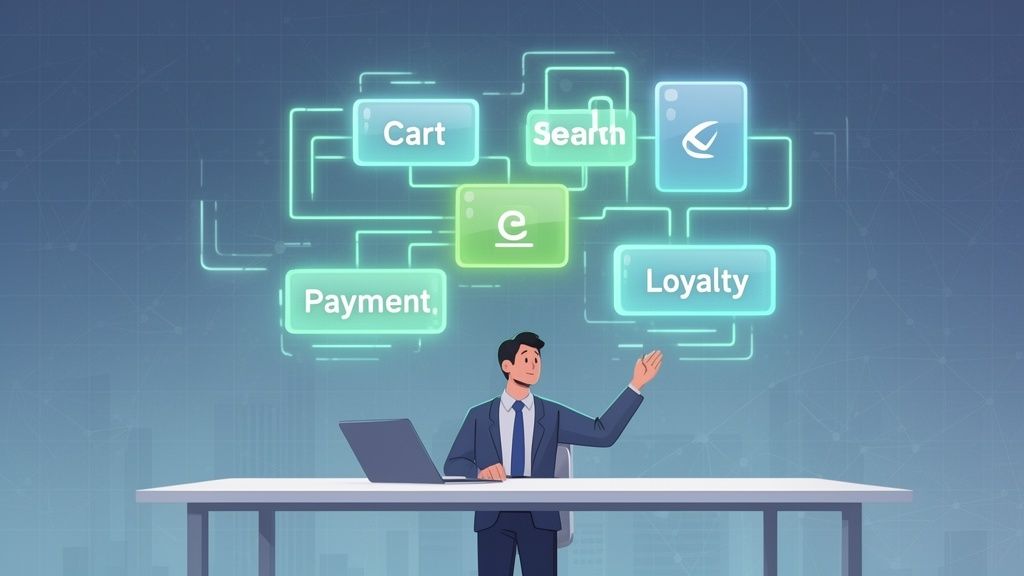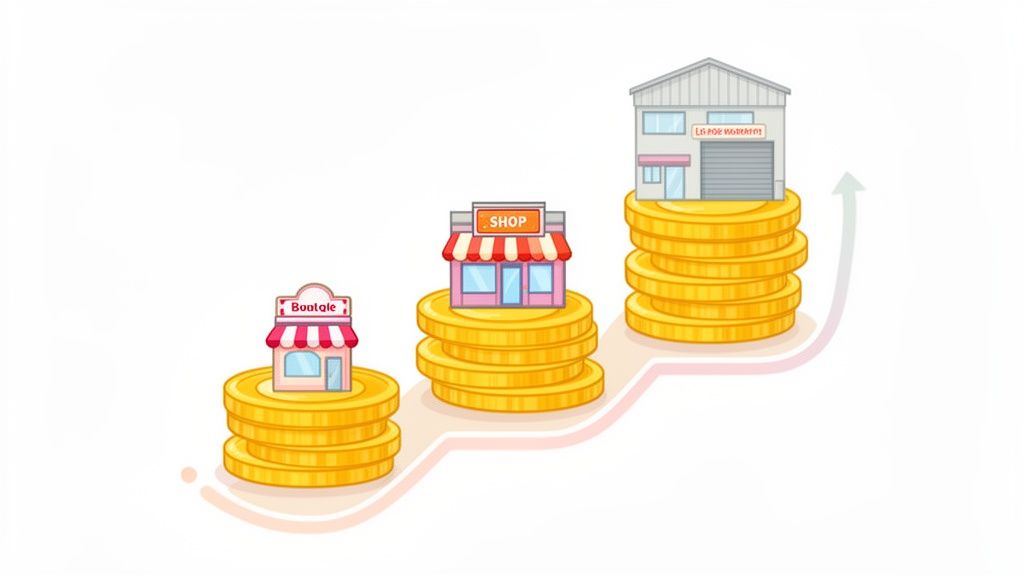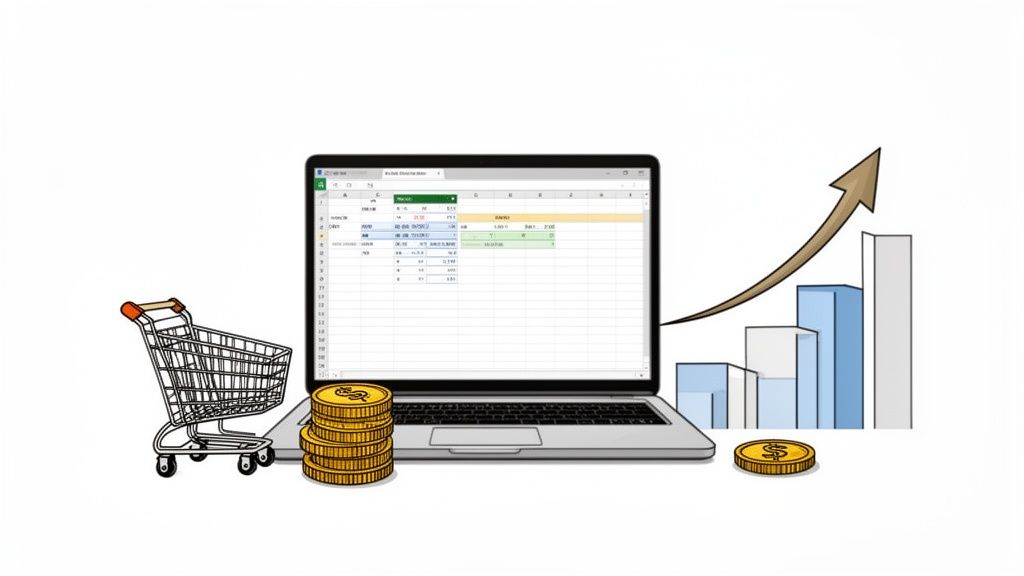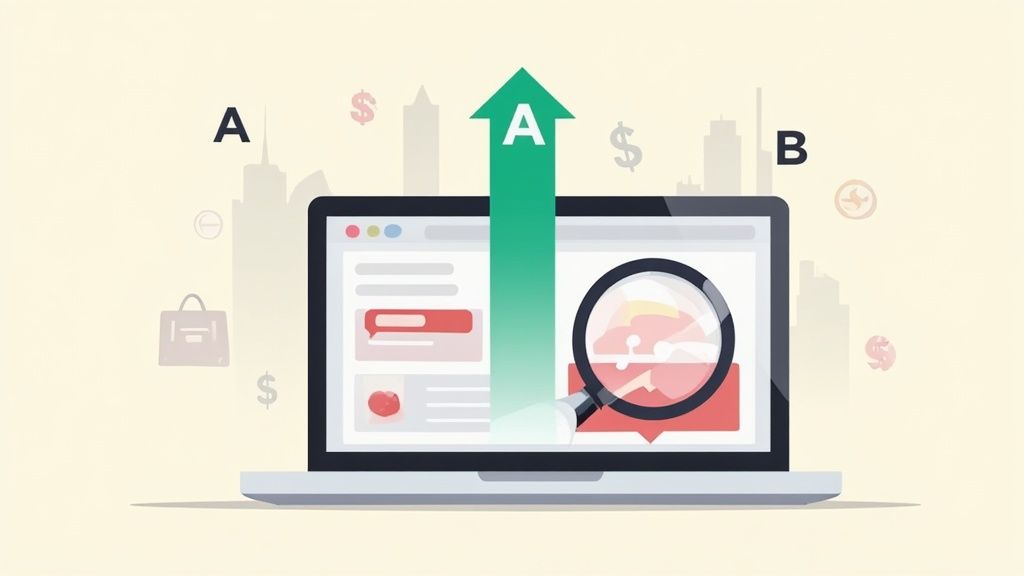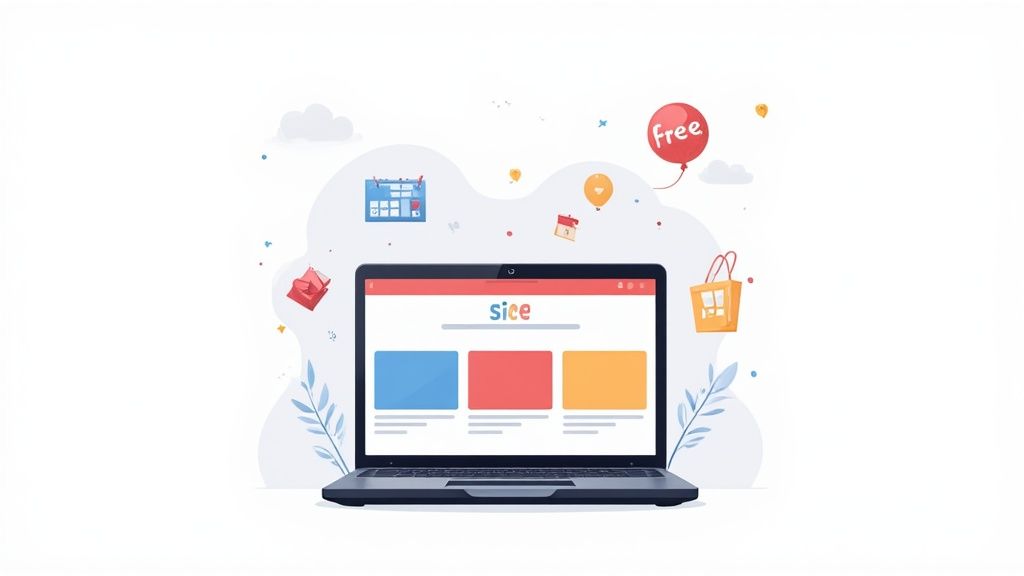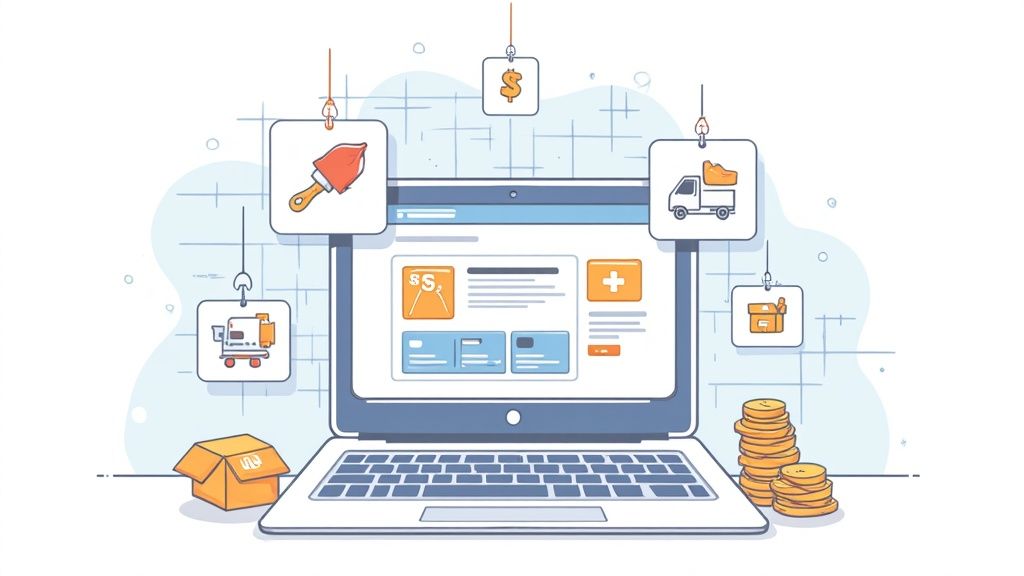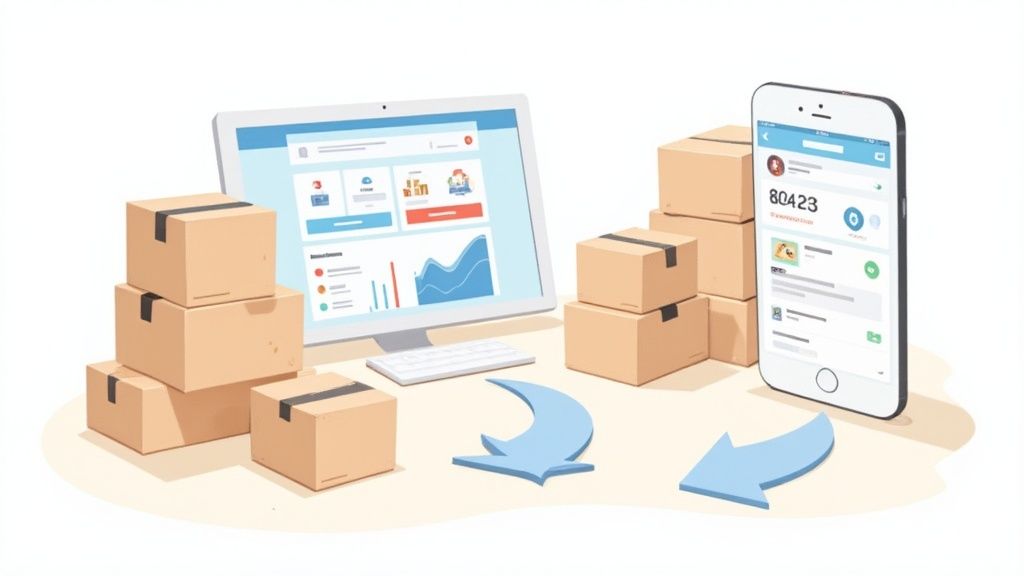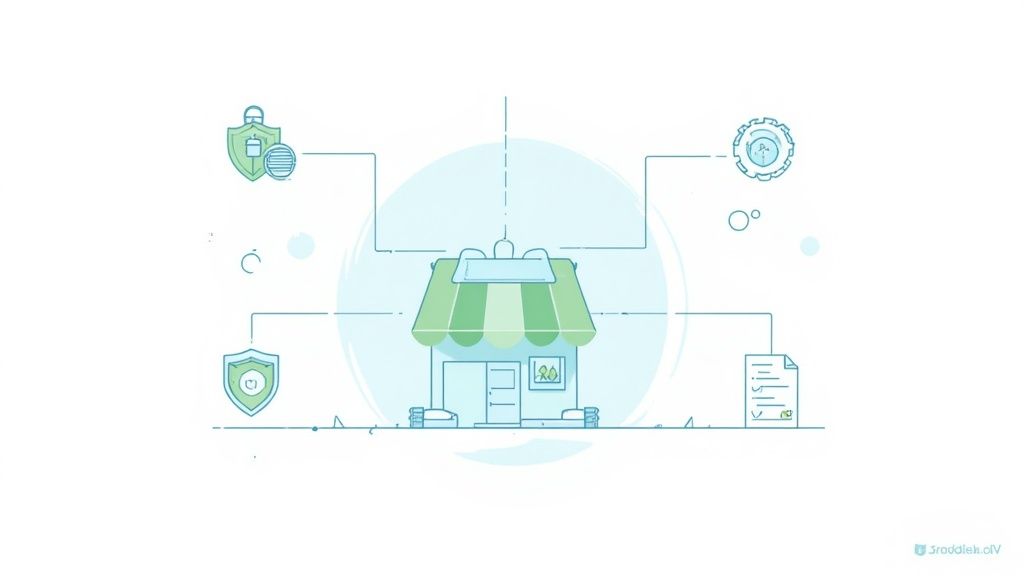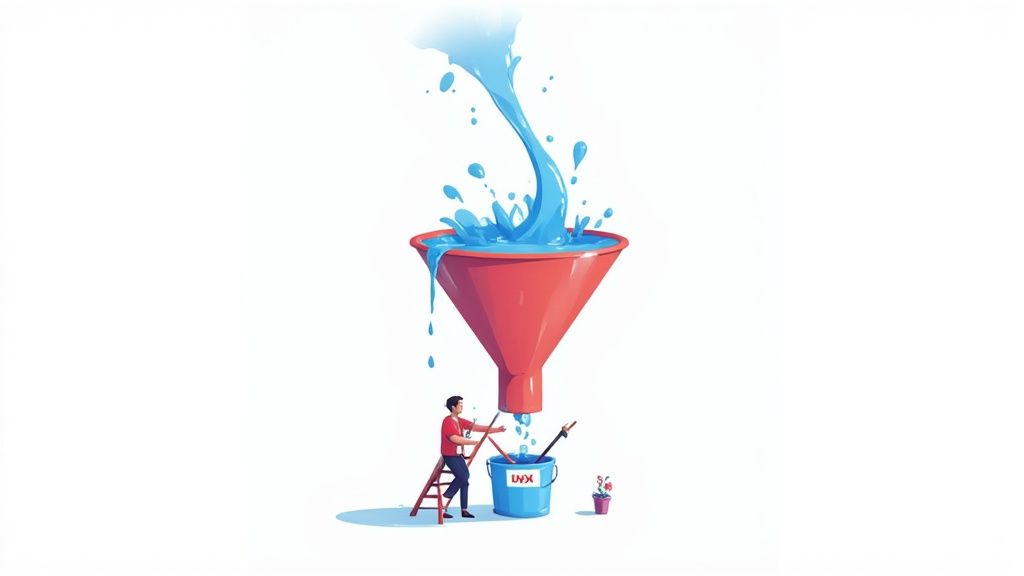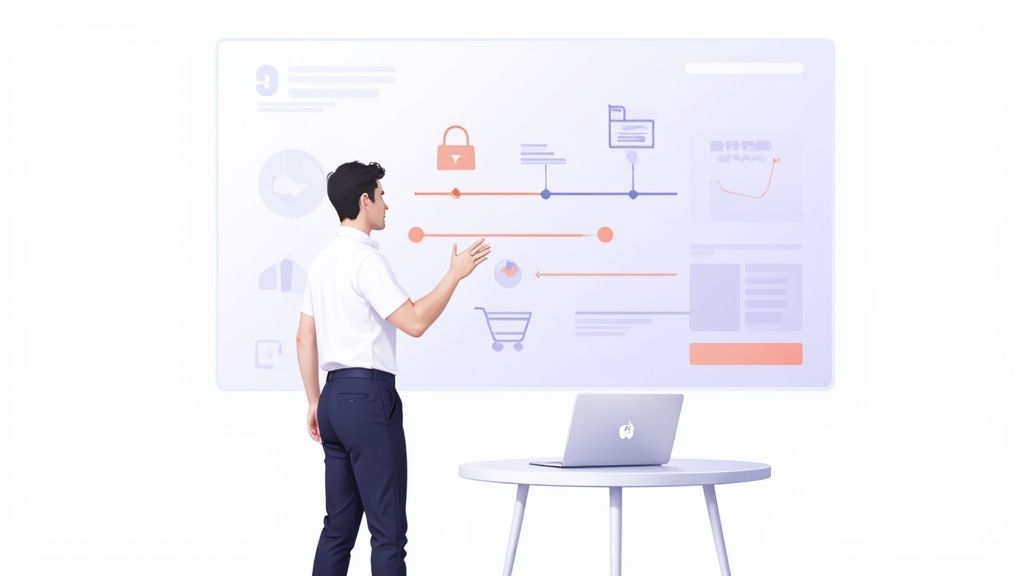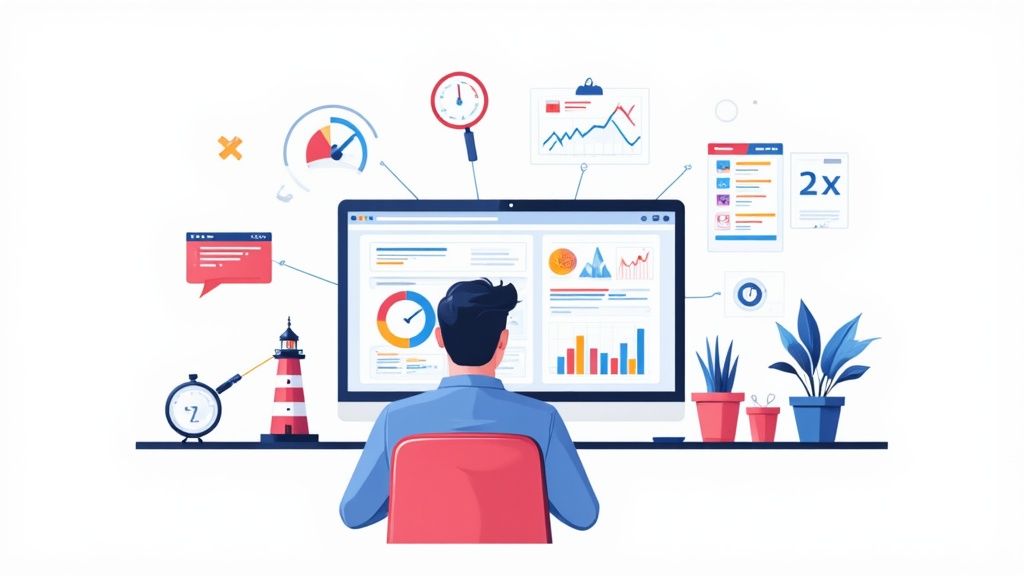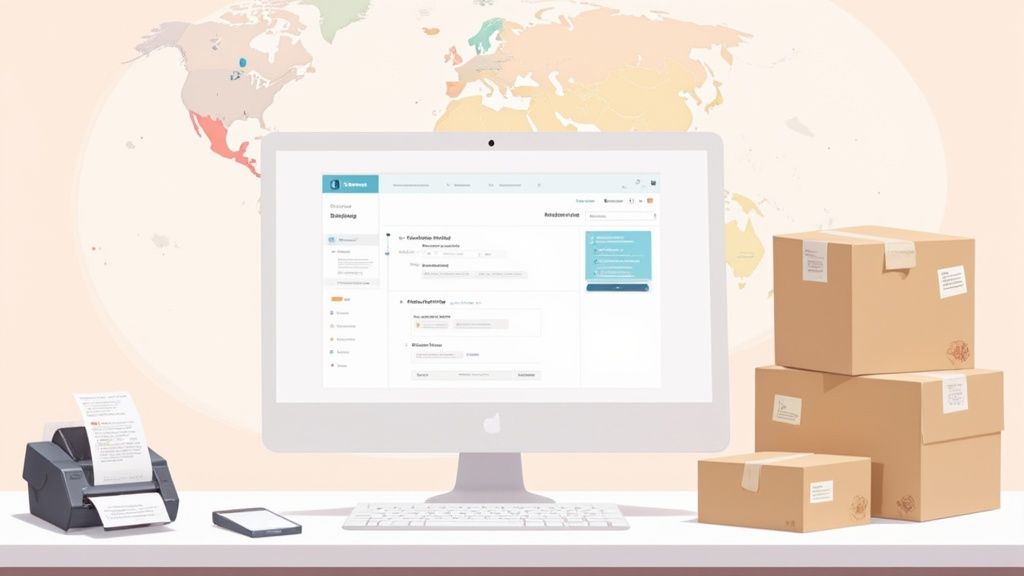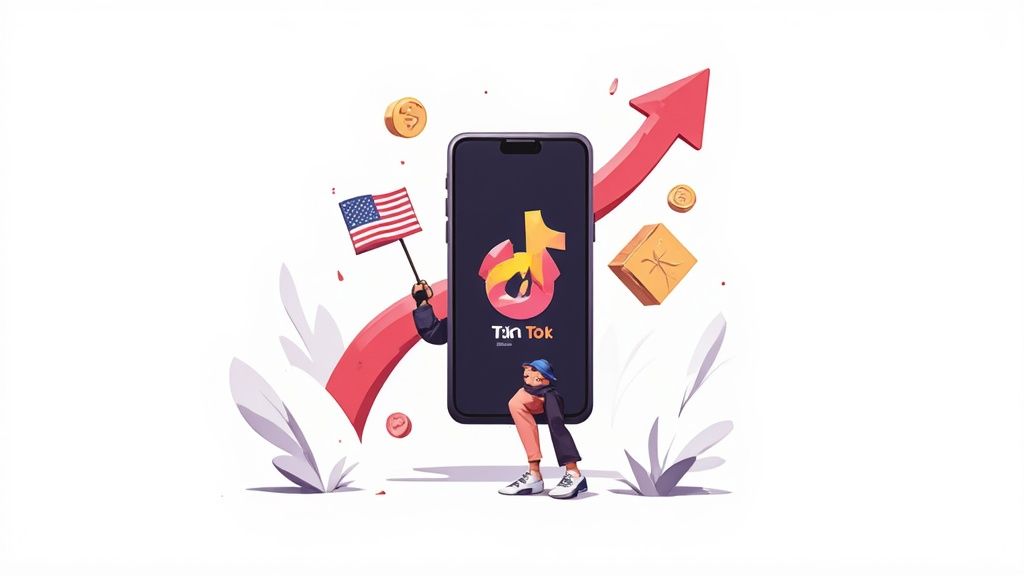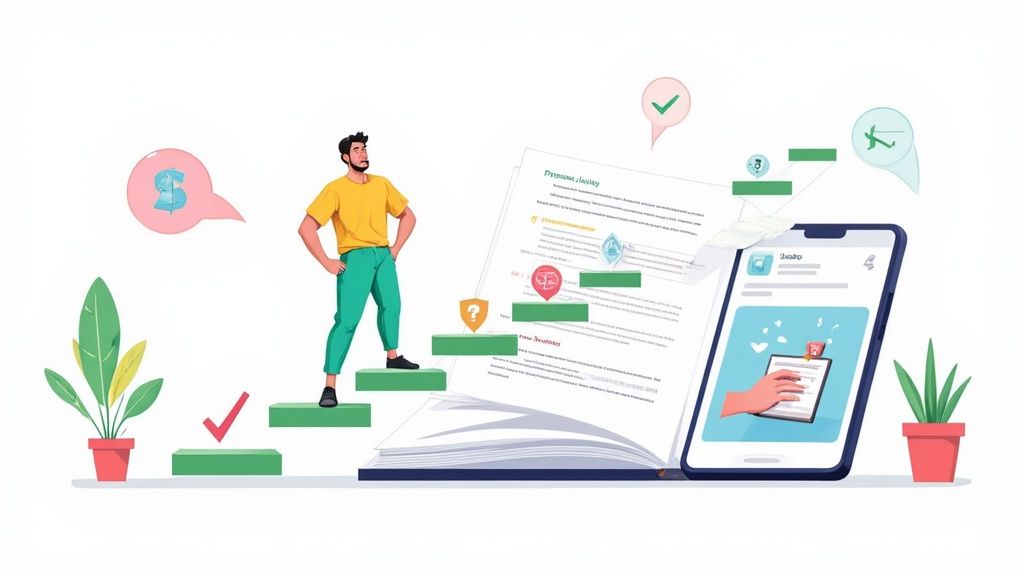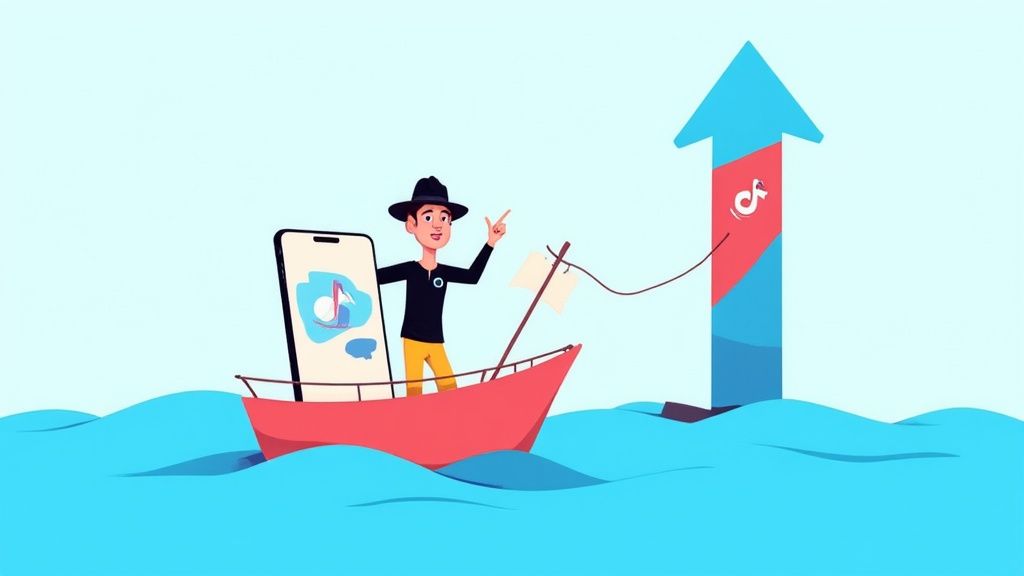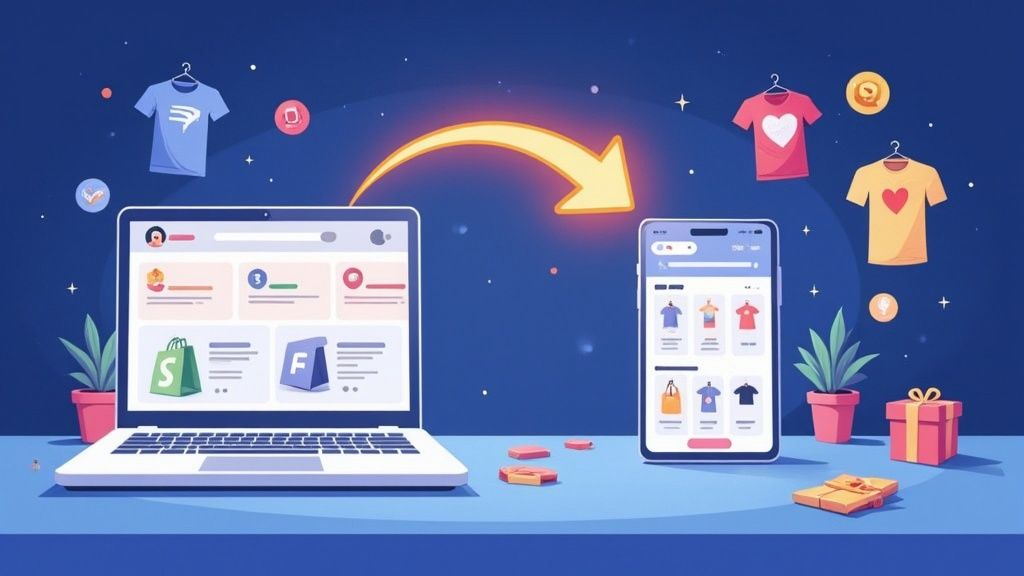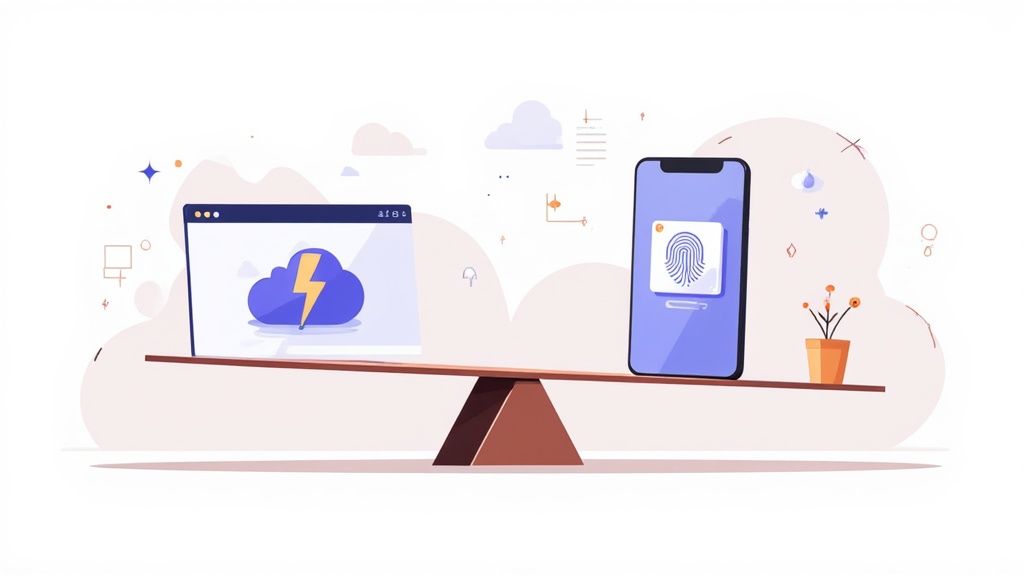
In the crowded digital marketplace, visibility is everything. While beautiful design and a seamless user experience are crucial, the true engine driving sustainable organic growth is often working behind the scenes: a powerful backlink profile. For ecommerce businesses, backlinks are more than just a technical SEO metric. They are digital votes of confidence from across the web that tell search engines your store is credible, authoritative, and deserving of a top spot in search results.
At its core, link building is a fundamental aspect of search engine optimization. To fully grasp its importance, it's essential to have a solid understanding of off-page SEO, which focuses on activities done outside of your website to improve its search engine rankings. A strong off-page strategy signals trust and relevance to Google, directly impacting your ability to attract qualified customers.
However, generic tactics fall short for online stores. The key lies in deploying specialized link building strategies for ecommerce that not only build authority but also drive relevant referral traffic and, ultimately, sales. This article moves beyond the basics, offering a comprehensive roadmap for boosting your store's domain authority and online presence.
You will learn nine actionable, ecommerce-specific strategies designed to build a robust backlink portfolio that fuels growth. We will explore how to:
- Turn your products into linkable assets.
- Leverage competitor insights and community connections.
- Create content that naturally attracts high-authority links.
Each strategy is broken down into practical steps, ensuring you can start implementing them immediately to achieve measurable results. Let's dive in.
1. Product-Based Link Building
One of the most powerful yet often overlooked link building strategies for ecommerce involves leveraging the very assets you sell: your products. Instead of relying solely on traditional content marketing, this approach turns your product catalog into a dynamic engine for acquiring high-quality backlinks. It treats your products not just as inventory, but as linkable assets that can attract natural attention from bloggers, reviewers, industry publications, and niche communities.

The core principle is simple: use your unique products to generate genuine interest and coverage. This could involve sending products to influencers for review, creating compelling demonstration videos, or building entire campaigns around a product launch. For example, Purple Mattress earned thousands of organic links by creating viral videos like the "Raw Egg Test" that showcased their product's unique qualities in a highly shareable format. Similarly, Dollar Shave Club’s witty launch video became a viral sensation, generating massive media coverage and links from top-tier publications.
How to Implement This Strategy
This strategy is particularly effective for stores with unique, innovative, or visually appealing products. By showcasing what makes your product special, you provide a tangible reason for others to link back to your site.
Actionable Steps:
- Identify Your Link-Worthy Products: Pinpoint items in your inventory that are either highly photogenic, have a unique feature, solve a common problem in a novel way, or have an interesting origin story. These are your primary candidates for outreach.
- Develop a "Digital PR Kit": For your star products, create a dedicated kit that includes high-resolution images, detailed specification sheets, usage guides, and a brief on the product's unique selling proposition. This makes it easy for journalists and bloggers to feature you.
- Launch a Product Seeding Campaign: Strategically send your products to relevant micro-influencers and niche bloggers for honest reviews. The key is to target creators whose audience perfectly aligns with your customer base, as their endorsement will appear more authentic and drive relevant traffic.
- Create Compelling Product Content: Go beyond standard product descriptions. Create detailed case studies, in-depth video demonstrations, or "behind-the-scenes" content about a product's creation. This content becomes a valuable resource that others in your industry may reference and link to.
2. Resource Page Link Building
Another highly effective link building strategy for ecommerce involves earning placements on high-value industry resource pages. This targeted approach focuses on getting your store, products, or content featured on curated lists, tool directories, and "best of" compilations that bloggers, educational institutions, and industry authorities create to help their audience. These pages act as trusted hubs of information, making a link from them a powerful signal of authority and a source of qualified referral traffic.
The following summary box highlights the key benefits and expected outcomes of a well-executed resource page outreach campaign.
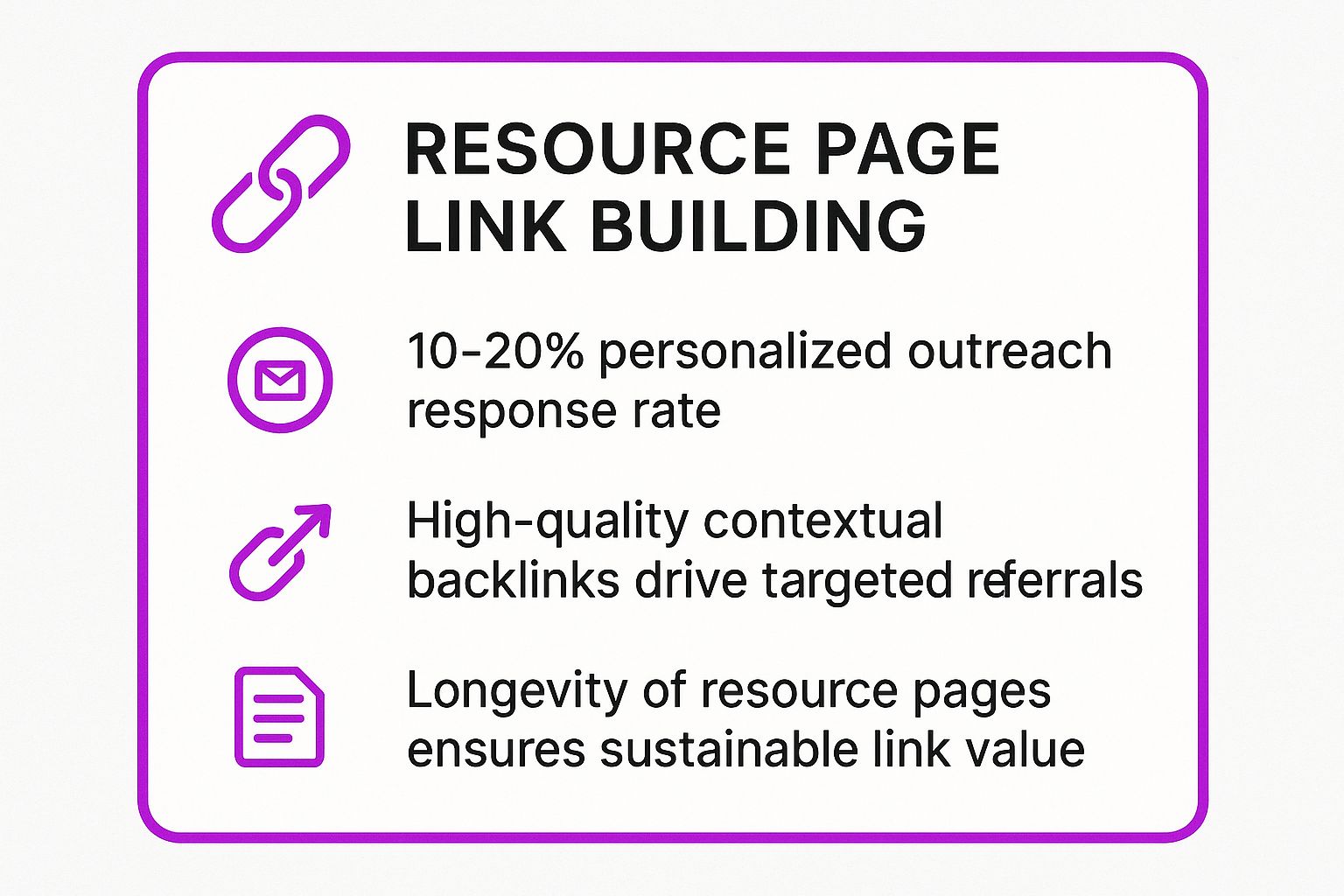
As the data shows, the value extends beyond just the link itself; these placements drive targeted traffic and offer sustainable SEO benefits due to their longevity. For instance, a brand like Canva earns hundreds of high-authority links by being featured on "best graphic design tools" resource pages, while Ahrefs is a staple on countless SEO and marketing resource lists. This strategy positions your brand as a go-to solution within your niche.
How to Implement This Strategy
This strategy is ideal for ecommerce stores that offer unique tools, have a well-defined niche, or provide valuable informational content alongside their products. The goal is to find existing, relevant resource pages where your store would be a natural and valuable addition for the reader.
Actionable Steps:
- Find Resource Page Opportunities: Use advanced Google search operators to uncover relevant pages. Try queries like
inurl:resources "your keyword",intitle:"useful links" "your keyword", or"your keyword" + "helpful resources"to find prospect lists. - Prioritize Recently Updated Pages: Focus your outreach efforts on pages that have been updated recently. This indicates the site owner actively maintains the content and is more likely to consider adding new, valuable links.
- Craft a Compelling Value Proposition: When you reach out, don't just ask for a link. Explain why your store or product is a perfect fit for their audience. Prepare a concise, one-line description of your business to make it incredibly easy for them to add you.
- Offer to Enhance Their Page: Suggest additional value beyond just your link. You could offer to provide a unique description, high-quality images of your product in action, or even point out a broken link on their page as a helpful gesture before making your request.
3. Broken Link Building
One of the most effective and mutually beneficial link building strategies for ecommerce is broken link building. This classic white-hat technique involves finding broken outbound links on other websites within your niche and reaching out to the site owner, suggesting your relevant product or content page as a replacement. You are essentially doing the webmaster a favor by helping them fix a "404 not found" error, which improves their user experience and site health, while earning a valuable backlink in return.
The core principle is value exchange. Instead of just asking for a link, you are first providing help. For an ecommerce store, this could mean finding a resource page listing "best hiking boots" that links to a discontinued product on a competitor's site. You can then reach out and suggest they replace the dead link with a link to your own, superior hiking boot page. SEO authority sites like Moz and Backlinko have long championed this method, documenting significant successes by replacing broken links pointing to outdated marketing resources with their own comprehensive guides.
How to Implement This Strategy
This strategy is perfect for ecommerce sites that have strong category pages, detailed product guides, or blog content that serves as a useful resource. It allows you to build contextually relevant links on pages that are already linking out to similar content or products.
Actionable Steps:
- Identify Target Websites: Find resource pages, blog posts, or curated lists in your niche that are likely to link out to other sites. Think "best of" lists, "how-to" guides, or local business directories. Tools like Ahrefs' Content Explorer or a simple Google search for "your keyword" + "resources" can uncover these opportunities.
- Find Broken Links: Use tools like the Check My Links browser extension or Ahrefs' Site Explorer to scan your target pages for broken links. You can also use Screaming Frog to crawl an entire site and filter for external 404 errors.
- Find a Suitable Replacement: Once you find a broken link, identify a page on your own ecommerce site that would be a perfect replacement. This could be a product page, a category page, or an in-depth blog post. Ensure your replacement is high-quality and a better fit than the original dead link.
- Craft Personalized Outreach: Send a concise and friendly email to the website's owner or editor. Point out the specific broken link you found, explain the poor user experience it creates, and politely suggest your page as a valuable and working replacement. Personalization is key to a higher success rate.
4. Digital PR and Newsworthy Content
This strategy elevates link building from simple outreach to a sophisticated public relations exercise. Digital PR for ecommerce involves creating newsworthy campaigns, data-driven reports, or compelling stories that journalists, bloggers, and industry publications genuinely want to cover. Instead of asking for links, you create assets so valuable that media outlets are naturally incentivized to write about you and link back, granting you high-authority backlinks.

The goal is to become the source of information, not just another store. For instance, Klaviyo's annual ecommerce marketing benchmarks report earns extensive coverage from marketing publications because it provides unique, data-backed insights. Similarly, Shopify’s regular trend reports are frequently cited by major business news sites, securing powerful links. By publishing original research or a unique story, you position your brand as an authority whose data is worth referencing.
How to Implement This Strategy
Digital PR is one of the most effective link building strategies for ecommerce stores looking to build domain authority and brand credibility at scale. It works by creating assets that are inherently interesting to a wider audience beyond just your direct customers.
Actionable Steps:
- Create Data-Driven Reports: Leverage your internal sales data (anonymously) to create reports on consumer trends, purchasing behavior, or industry growth. BigCommerce successfully did this with studies on COVID-19's impact on ecommerce, gaining media features.
- Utilize HARO and Qwoted: Actively monitor platforms like Help A Reporter Out (HARO) and Qwoted. Providing expert quotes in your niche is a direct way to earn backlinks from high-authority news and media sites.
- Develop Newsworthy Angles: Tie your brand or products to current events, seasonal trends, or a unique human-interest story. This could be a campaign around a social cause, a partnership announcement, or a milestone achievement.
- Build Relationships with Journalists: Identify and follow reporters who cover your industry. Engage with their work thoughtfully before pitching your story. A personalized pitch to a relevant contact is far more effective than a mass email blast.
5. Influencer and Blogger Outreach
One of the most authentic and powerful link building strategies for ecommerce is building genuine relationships with key voices in your niche. Influencer and blogger outreach moves beyond transactional exchanges to cultivate authentic partnerships with creators whose audiences trust their recommendations. This strategy harnesses the power of third-party credibility to generate high-authority backlinks, drive targeted traffic, and build brand awareness.
The core principle is to leverage an influencer's established trust to introduce your products to a new, engaged audience. When a respected blogger reviews your product or an influencer features it in their content, the resulting mention often includes a direct link back to your store. For example, beauty brand Glossier built its empire by collaborating with micro-influencers, turning genuine product love into a powerful engine for organic mentions and links. Similarly, MVMT Watches gained massive traction by partnering with lifestyle bloggers who integrated their products into style guides and review posts.
How to Implement This Strategy
This relationship-based approach is ideal for brands in visually-driven or passion-led niches like fashion, beauty, wellness, and home decor. It works by providing value to creators, empowering them to produce content that feels natural to their followers and beneficial for your brand. A successful campaign requires personalization and a focus on mutual benefit, not just a one-way request for a link. If you want to dive deeper into this topic, you can learn more about influencer marketing for ecommerce on ecorn.agency.
Actionable Steps:
- Focus on Micro-Influencers: Target creators with smaller, highly engaged followings. Their endorsements often feel more authentic, and they typically have higher engagement rates and are more accessible for collaboration.
- Research Audience Alignment: Use influencer marketing tools or manually review a creator's content and audience demographics. Ensure their followers match your ideal customer profile to maximize relevance and ROI.
- Offer Genuine Value: Go beyond just sending free products. Offer exclusive discount codes for their audience, early access to new launches, or set up an affiliate partnership that provides them with a commission on sales.
- Encourage Creative Freedom: Provide clear brand guidelines but avoid overly restrictive scripts. The most effective content comes from allowing influencers the creative freedom to feature your product in a way that feels genuine to their personal brand and audience.
6. Content Marketing and Educational Resources
Beyond just selling products, one of the most sustainable link building strategies for ecommerce is establishing your brand as a trusted authority. This long-term approach involves creating valuable, in-depth educational content that serves as a definitive resource for your niche. Instead of chasing individual links, you build a library of "linkable assets" that naturally attract backlinks over time from bloggers, journalists, and industry peers who need to cite a credible source.
The principle behind this strategy is to answer the questions your customers are asking before they are ready to buy. By providing genuine value, you build trust and authority. For example, REI's comprehensive "Expert Advice" library on outdoor gear and skills earns thousands of links from camping blogs and travel sites. Similarly, Home Depot's extensive DIY project guides are frequently cited by home improvement and lifestyle publications, positioning them as the go-to experts in the space.
How to Implement This Strategy
This approach is ideal for brands in niches where customers conduct significant research before purchasing. It positions you not just as a retailer, but as a thought leader and reliable guide, building brand equity and attracting high-authority links that boost your entire domain's SEO performance.
Actionable Steps:
- Identify Customer Questions: Use tools like AnswerThePublic, Ahrefs' Questions report, or simply browse forums like Reddit and Quora to find the most common questions and problems your target audience faces. This forms the foundation of your content calendar.
- Create "Skyscraper" Content: Find the top-ranking content for your target topic and create something significantly better. Make it more comprehensive, better designed, more up-to-date, or include original data and custom graphics to make it the definitive resource.
- Develop Buying Guides and How-To's: Create detailed buying guides that help customers choose the right product for their needs or step-by-step tutorials that show them how to use your products effectively. These are highly linkable assets for other content creators.
- Promote Your Content Strategically: Creating great content is only half the battle. Promote it through your email newsletter, social media channels, and targeted outreach to bloggers and publications who have linked to similar, less comprehensive resources in the past.
7. Competitor Link Analysis and Replication
One of the most efficient link building strategies for ecommerce is to learn from those already succeeding. Instead of starting from scratch, this method involves systematically analyzing your top competitors' backlink profiles to uncover the sources and tactics that are working in your niche. By reverse-engineering their success, you can identify high-value, relevant link opportunities and create a data-driven outreach plan.
The core principle is leveraging competitive intelligence to build a smarter, more effective link building campaign. For example, by studying how Allbirds consistently earns links from top-tier publications through its sustainability narrative, a new eco-friendly shoe brand can identify key environmental blogs and journalists to target. Similarly, a fitness apparel startup could analyze Gymshark’s extensive network of influencer collaborations to find potential partners for its own launch. This isn’t about simple imitation; it's about identifying proven channels and then approaching them with your unique value proposition.
How to Implement This Strategy
This strategy is foundational for any ecommerce business, regardless of size or niche, as it provides a clear roadmap based on proven results. It helps you prioritize your efforts by focusing on link sources that have already shown a willingness to link to businesses like yours.
Actionable Steps:
- Identify and Analyze Key Competitors: Use SEO tools like Ahrefs, Semrush, or Moz to pull the backlink profiles of 3-5 of your closest competitors. Look for high-authority domains, resource pages, guest posts, and media mentions.
- Segment Link Opportunities: Categorize the links you find. Are they from product reviews, industry roundups, "best of" lists, resource pages, or news articles? This helps you understand which types of content attract links in your market.
- Look for Replicable Patterns: Focus on patterns rather than one-off wins. If multiple competitors are getting links from guest posts on a specific set of blogs, that’s a strong signal. If they are all featured on a particular "Top 10" list, that page is a high-priority target.
- Craft a Superior Pitch: When you reach out to a site that has linked to a competitor, don't just ask for a link. Offer something better: a more comprehensive resource, a newer product, or a unique expert insight that provides more value to their audience. This differentiates your brand and increases your chances of success.
8. Local SEO and Community Link Building
For ecommerce businesses with physical stores or those targeting specific geographic markets, local link building is a highly effective strategy that bridges the digital and physical worlds. This approach focuses on building relationships within your local community to earn high-authority backlinks from trusted local sources. It transforms your local presence from a simple sales channel into a powerful asset for online authority and search engine visibility.
The core principle is to become an active, recognized part of your local ecosystem. This means engaging with other local businesses, sponsoring community events, and creating content that serves your immediate area. For instance, a local furniture store could earn links from area interior design blogs, or a community-focused retailer could get featured in local news for a charity partnership. These links are valuable because they are highly relevant and signal to search engines that your business is a legitimate, trusted entity in a specific location.
How to Implement This Strategy
This strategy is essential for any ecommerce brand with a brick-and-mortar footprint or a strong regional customer base. By embedding your brand in the local community, you tap into a network of potential link partners that national competitors cannot easily access, making it a key part of your overall link building strategies for ecommerce.
Actionable Steps:
- Audit Local Citations: Use tools like Moz Local or BrightLocal to find existing mentions of your business online. Ensure your Name, Address, and Phone number (NAP) are consistent across all directories like Yelp, Google Business Profile, and local chamber of commerce sites.
- Engage in Local Events: Sponsor a local youth sports team, host a workshop, or participate in a community festival. Document your involvement with photos and a blog post, then share it with local news outlets and event organizers, creating natural opportunities for them to link back to your site.
- Build Relationships with Local Media: Identify and connect with local journalists, bloggers, and influencers. Offer to be a source for stories related to your industry or provide them with products for local-focused guides, such as a "shop local" holiday gift guide.
- Create Hyper-Local Content: Develop content specifically for your local audience. This could be a guide to "The Best Dog-Friendly Patios in [Your City]" if you sell pet supplies, or a feature on local artisans if you sell home goods. This type of resource is highly linkable for other local businesses and publications.
9. Technical SEO and Link-Worthy Tools
One of the most sustainable link building strategies for ecommerce involves creating assets that provide continuous value, long after they are published. This strategy focuses on developing free, useful tools, calculators, or interactive resources that solve a specific problem for your target audience. Instead of chasing individual links, you build a "link magnet" that naturally attracts citations and shares from industry blogs, resource pages, and communities because it offers genuine utility.
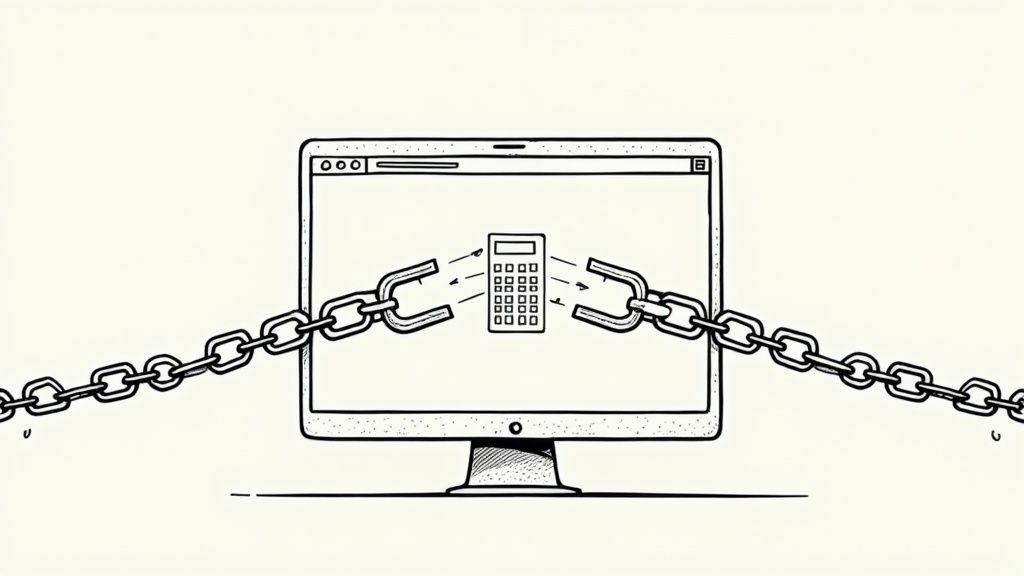
The principle behind this approach is value exchange. By providing a helpful resource at no cost, you create a powerful incentive for other websites to link to you. For instance, Shopify's profit margin calculator has earned countless backlinks from business and entrepreneurship sites because it helps new store owners with a crucial calculation. Similarly, CoSchedule's Headline Analyzer is frequently cited in content marketing guides, generating high-authority links because it serves a clear purpose for writers and marketers.
How to Implement This Strategy
This strategy is highly effective for brands that can identify and solve a common pain point or calculation within their niche. The key is to create a tool that is not only useful but also superior to or more user-friendly than existing alternatives. This solidifies your site as a go-to resource.
Actionable Steps:
- Identify Audience Needs: Brainstorm common questions, calculations, or challenges your customers face. A furniture store could create a "Room Layout Planner," while a fitness brand might build a "Macro Calculator."
- Develop a Genuinely Useful Tool: Focus on utility over lead generation. The primary goal is to provide value, which will earn links. Avoid making the tool overly promotional or gating it behind an aggressive lead capture form.
- Ensure Technical Excellence: The tool must be fast, mobile-friendly, and easy to use. A clunky or slow-loading resource will deter users and fail to attract links. Ensuring your site's technical foundation is sound is a critical first step; you can get started with this comprehensive eCommerce SEO checklist.
- Promote Your New Asset: Once launched, promote the tool through blog posts, social media, and outreach to relevant websites that have "resources" or "tools" pages. Highlight how it can help their audience.
Link Building Strategies Comparison Matrix
Building Your Ecommerce Link Strategy for Lasting Growth
We've journeyed through a comprehensive playbook of nine powerful link building strategies for ecommerce, each offering a unique pathway to enhancing your store's authority and visibility. The path from obscurity to organic search dominance is not built on a single tactic but on a well-orchestrated, persistent campaign that integrates multiple approaches. This isn't about finding one "magic bullet"; it's about building a versatile and resilient link-building engine.
The strategies we've detailed, from leveraging your own products for reviews to engineering newsworthy Digital PR campaigns, share a common thread: value. Google's algorithms are increasingly sophisticated, rewarding websites that earn links by being genuinely useful, interesting, or authoritative. Chasing low-quality, spammy links is a short-term game with long-term risks. Instead, the focus must be on creating assets, relationships, and experiences that other sites want to link to.
Synthesizing Your Strategy: From Tactics to a Cohesive Plan
Moving forward, the key is to avoid getting overwhelmed. You don't need to implement all nine strategies at once. The most successful brands are strategic, focusing their resources where they can make the biggest impact.
Here’s how to translate this knowledge into an actionable plan:
- Audit Your Assets: Start by evaluating what you already have. Do you have unique products perfect for product-based link building? Do you possess proprietary data that could be turned into a compelling report for Digital PR? Do you have an active blog that can be a hub for content marketing efforts?
- Analyze Your Niche: Look at your competitors. What's working for them? A deep dive using competitor analysis tools can reveal if they are succeeding with resource page link building or if they have a strong local presence built through community partnerships. This isn't about blind copying; it's about identifying opportunities and gaps you can exploit.
- Prioritize Based on Resources: Be realistic about your team's capacity. Broken link building and competitor link replication can be time-intensive but offer a high ROI. Creating a link-worthy tool requires significant technical investment but can become a passive link-generating magnet for years. Choose one or two strategies that align with your current budget and skillset.
The ultimate goal is to create a diversified backlink portfolio. Over-reliance on a single tactic, like guest posting, can make your profile look unnatural and vulnerable to algorithm updates. A healthy mix of links from product reviews, resource lists, news articles, and educational content creates a robust and authoritative signal to search engines.
The Power of a Long-Term Vision
Remember, the most impactful link building strategies for ecommerce deliver compounding returns. The authority you build this quarter will fuel your organic traffic for the next. The relationships you forge with influencers and journalists today can lead to more opportunities tomorrow. Each high-quality link is a vote of confidence that strengthens your entire domain, lifting the rankings of all your pages, from product listings to category pages.
This consistent, value-driven approach transforms link building from a tedious SEO chore into a core business activity that drives brand awareness, referral traffic, and ultimately, sustainable revenue growth. It's an investment in your brand's digital foundation, ensuring it not only survives but thrives in the competitive ecommerce landscape. By embracing creativity, persistence, and a strategic mindset, you can build a powerful backlink profile that serves as a lasting competitive advantage.
Ready to move from planning to execution and see real results? The strategies outlined here require expertise and dedicated resources. If you're looking to accelerate your growth and implement a sophisticated, data-driven link building campaign, the team at ECORN can help. As a specialized agency in Shopify development, CRO, and strategic ecommerce consulting, we build the powerful systems that turn traffic into revenue.






